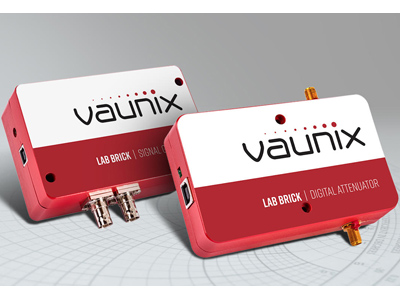Vaunix Technology Corp. is pleased to announce that their lineup of self-programmable wireless ATE devices continues to grow in response to customer demand. Vaunix has built an impressive library of over 60 products called Lab Bricks™, that are revolutionizing the way engineers are looking at the equipment― and methodology―surrounding today’s fading simulation, handover testing and other wireless system test design and development approaches, including 5G MIMO and IFF radar.
In ATE systems, an expensive and bulky instrument controller is often necessary to handle a variety of complex interoperability tasks. However, when you’re controlling just a few devices to accomplish a measurement or simulation task, this piece of equipment is often overkill. As wireless test engineers are now adopting a self-programming approach to controlling, configuring and running routines utilizing independent, function-specific components, Vaunix’ s simple yet effective Lab Bricks and their Windows-based software are earning high marks for their combined performance and ease of use.
“In every case, we have stressed continuity. That is, whether you’re operating our signal generators, phase shifters, attenuators or switches together or independently, all adjustments you make are performed almost identically,” said Scott Blanchard, president and co-founder of Vaunix. “This makes everything, from setup to operation, far easier than if all the user interfaces were different. You can configure and control these products from a single interface, rather than through layers of menus.”
Once you connect a Vaunix Lab Brick to a laptop or other computer, the software automatically identifies it, loads the parameters (attenuation, phase, power, modulation type, etc.) stored in the device (or devices), and lets you change settings on the fly to see what effect they have on the device under test (DUT). This is helpful in evaluating an amplifier on an evaluation board, for example.
You can control as many Lab Brick signal generators, attenuators, phase shifters and switches as you choose, which thanks to USB, is very simple. You can switch between them, increase or reduce values, configure test sequences (including all key parameters) and much more.
“It’s like having an instrument controller ‘in miniature form,’" Blanchard continues. “Almost every new customer expresses how thrilled they are to have found us, and how simple and effective our software is. They all want to get set up and running fast.”
Lab Bricks’ unique and adjustable feature set is made available via the USB port of your PC, which is also how they derive power. Features include: frequency sweep triggering; pulse modulation; frequency stepping; high switching speed; and fixed/swept attenuation ramps, to name a few.
Recent developments include the release of the following new products:
- The LDA-5018V is a bi-directional, 50 ohm digital attenuator that provides calibrated attenuation from 50 MHz to 18 GHz with an exceptionally precise step size of just 0.1 dB, while offering typical accuracy of < 1 dB over 50 dB of control range. Price is $899.
- The LDA-133 is Vaunix’s response to customer requests for a wide bandwidth 50 ohm attenuator. It provides fast attenuation changes from 10 MHz to 13 GHz with a step size of 0.5 dB and 63 dB of control range. Price is $649.
- A versatile 4-port programmable attenuator comes in the form of model LDA-602Q. It is capable of bidirectional fixed attenuation, swept attenuation ramps, and fading profiles and provides up to 120 dB of control range with a 0.1 dB step size from 200 MHz to 6 GHz. A switching speed of 15 microseconds is typical. Price is $2,900.
- Model LMS-183DX Is a programmable signal generator offering a power control range of 80 dB, +10 to -70 dBm from 6 to 13 GHz, and a power control range of 65 dB, +10 to -55 dBm from 13 to 18 GHz. Price is $3,499.
- Featuring excellent harmonic performance of -40 dBc, the model LMS-802DX signal generator has a power control range of 80 dB, +10 dBm to -70 dBm (exceeding the range of its predecessors by 25 dBm). The unit operates in the 2 to 8 GHz frequency range with a resolution of 100 Hz and a fast 100 microsecond switching time. Price is $3,249.
- Additional new products include single pole, double throw and a single pole, four throw switches, 2 to 4 and 4 to 8 GHz phase shifters and a 0.5 MHz to 270 MHz signal generator with a 100 microsecond switching time.


